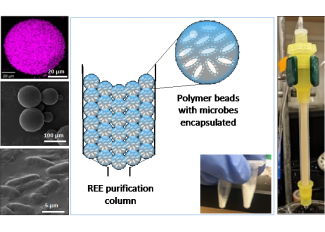The National Energy Technology Laboratory (NETL) is partnering with Lawrence Livermore National Laboratory (LLNL), Duke University and the University of Arizona to develop a reactor that will selectively concentrate rare earth elements (REEs) in an environmentally benign way.
REEs are extracted from coal waste and used in various industries—such as energy, defense and medical—to perform vital functions in order for products to function. Making use of this coal waste, to recover REEs will continue to perform clean energy functions and create jobs for workers in coal communities. The U.S. Department of Energy (DOE) and NETL, with partners and collaborators at national laboratories, academia and other industries, are working on projects to develop a domestic supply of these resources, which are abundant in carbon ore and their by-products.
Biological materials are promising REE adsorbents (biosorbents) because they are inexpensive, and readily available, effective in treating chemical contaminants such as heavy metal pollutants, display high selectivity toward REEs and allow for high-density metal binding. These properties allow biosorbents to bind to REEs in a more environmentally benign way than other conventional separation and recovery methods that rely on toxic acids.
Building on bioengineering principles, the LLNL researchers developed a continuous biosorption reactor for REE recovery. The process consists of a two-stage recovery that selectively concentrates scandium, with the remainder of the stream passing through a second biosorption column in which the REEs and yttrium are concentrated.
Over the 3-year field work proposal (FWP) effort, the project successfully caried out research to determine a preferred encapsulation approach for the microbe Arthrobacter nicotianae, ultimately utilizing it in the continuous reactor system. In these microbeads, microbes are physically trapped within silicon sol-gel polymer beads that allow liquid, and REE ions to diffuse in and out of the beads. Successful in over 12 test cycles with no loss in the REE adsorption capacity, the result coupled with computational modeling suggests that the LLNL columns are stable for reuse for more than 100+ cycles projects. Further analysis indicated that a process like this is economically efficient.
“Over the years, NETL and its partners in academia, industry and DOE’s other national labs have explored methods of extracting REEs from carbon ore. Now, the work moves toward refining and optimizing concentration processes to be economically practical but also environmentally safe,” explained Anthony Zinn, project manager for NETL. “DOE-NETL’s funding of such projects all over the country is an extension of our commitment to providing the country’s energy needs sustainably, which will only grow more important as the Biden Administration works to decarbonize the U.S. economy.”
Multiple publications resulted from this work, including articles in International Journal of Coal Geology, Separation and Purification Technology, ACS Sustainable Chem. Eng. and Environmental Science & Technology. The team at LLNL has applied for a patent of the technology developed during this research with potentially more on the way.
NETL is a DOE national laboratory that drives innovation and delivers technological solutions for an environmentally sustainable and prosperous energy future. Through its world-class scientists, engineers and research facilities, NETL is ensuring affordable, abundant and reliable energy that drives a robust economy and national security, while developing technologies to manage carbon across the full life cycle, enabling environmental sustainability for all Americans, advancing environmental justice and revitalizing the economies of disadvantaged communities. Leveraging the power of workforce inclusivity and diversity, highly skilled innovators at NETL’s research laboratories in Albany, Oregon; Morgantown, West Virginia; and Pittsburgh, Pennsylvania conduct a broad range of research activities that support DOE’s mission to ensure America’s security and prosperity by addressing its energy and environmental challenges through transformative science and technology solutions.




